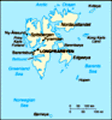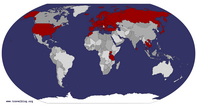Advertisement
Published: July 26th 2019
The plan last night was to stay awake so I could gaze at the passing landscape as we cruised from the Tuna glacier to Pyramiden between 11pm and 1am. But I gave up at 10.30pm. All the clean, cold and crisp air was making me sleepy; my body is missing some good old Stokey pollution. Plus the constant daylight is extremely disorientating too. Yes I have been sleeping with the port hole cover open (just because the sun not setting is so bizarre and I don’t want to miss it) so that doesn’t help.
We woke up around 7am, Pyramiden visible through the portholes, set like everything is set here: at the base of brown, arid hills with little to no vegetation, plus ugly and rusty industrial stuff.
Pyramiden is now a ghost town, populated mostly only in summer by tourism staff. It began life as a Russian mining town and was abandoned in the 1990s. The majority of the buildings and machinery are from the 1950s to 1970s and are homes to lots of smelly sea birds and foxes.
Unlike all our other stops, we could only get ashore by tender and that added to the fun

 blue fox
blue fox
Pyramidenas we bobbed on the sea with the arctic breeze whistling through the open windows. Upon arrival, our group was welcomed by Anna, our Russian guide. If you could bottle and sell Anna’s enthusiasm and humour, you’d be made for life. She was in her early twenties, full of energy and incredibly happy. A tiny lady in an oversized coat and rifle slung over her back in case of danger (polar bears), she has had training in using the gun, but liked it as an accessory to tell us she’s a dangerous lady - said with a knowing smile.
We had opted for the longest walking tour possible and it was incredibly fascinating. I do think the sunshine and warm temperature (warm for Svalbard that is) made it all seem far more appealing than living and working there would have been in reality. Many of the buildings are crumbling but must have been grand in their heyday. The number of tourists allowed there at a time is limited to 300 to protect the site, so other passengers were waiting for us to return. Anna asked us not to walk on the grass as it had been imported from the
Ukraine decades ago to feed the reindeer. Reindeers often die of starvation during the winter if they didn’t eat enough in the summer.
Pyramiden had been the poster mining town for Russia because of its proximity to European settlements, so an opportunity to prove to outsiders how good Communism is. So the food, drink, facilities, entertainment and medical supplies were free to all miners and their families. Plus the pay was far higher than any other mining town. They had a sports hall, swimming pool, cinema, hospital and school. There was a social hall/ bar where you could hang out. Single men and women resided in separate buildings named London and Paris respectively. Another building was named the madhouse due to it being very noisy as the children played there. It is still extremely noisy as on each and every windowsill was a bird poo drenched nest containing on average 3 kittiwakes. Anna says you get used to the noise when you live there (there’s modernised accommodation for staff and a Radison hotel!)
Anna said that living conditions would have been excellent (apart from the cold, isolation, dark winters and polar bear threats) but according to her parents
and grandparents, Communism wasn’t like this on the mainland. By contrast, other passengers on the shorter tour said their guide was completely towing the Communism line. Anna was taking the piss out of it. She invited us to take selfies with the most Northern statue of Lenin - but don’t expect him to smile, he’s always very serious. And whenever we didn’t keep up, not only did we need to be scared of the dangerous lady, but also that Lenin / Big Brother was watching. Only myself and Richard got told off, (me for lagging behind taking photos, Richard for stepping on the grass) but it was all done tongue in cheek.
The reason for Anna carrying a gun was that our tour went beyond the town limits, past the rusty football goal posts overlooked by the crumbling mine up above on the hillside. We climbed upwards towards the bottlehouse, a small and lonely building made from bottles as there had been a bottle graveyard and it seemed such a waste. This house was used for imbibing alcoholic beverages away from all the hubbub of the small town. It had a window and the bottle necks faced inwards; you
are allowed to blow tunes on them if you are careful.
Rumour has it that there once was a second bottlehouse, where the necks faced outwards. But the wind blowing into the bottles made so much noise, it was knocked down. Seems a daft idea to build it in the first place, but Anna reiterated it was a legend / rumour, but also a good story.
We returned back down into the town in time for the 11am viewing of an old 20 minute Russian film about Svalbard. It was crackly and brown, with a cheesy dose of happy propaganda. Another guide spoke over it in English, but we struggled to hear the translation. Afterwards we had coffee (better than that on the ship) and Russian cakes that were a bit dull and dry. I told Anna she was one of the best guides I’ve ever had, because she is and got my photo taken with her. Richard also wanted his photo with her too, but more of the rifle showing!
We were allowed to roam unchaperoned within the town limits, so Glyn, Richard and I went looking for Arctic foxes as we’d heard there was a
good chance of spying them. A couple from the ship told us there was an armed guard nearby feeding one, so we thanked them for the intel and set off.
We soon found him, sitting in a quiet spot against an old building, drinking some pop and interacting with a small dark fox with amber eyes. He wasn’t feeding it, but it certainly wasn’t scared of him and nipped at his boot. It was a lovely moment to watch and we sat quietly nearby, taking photos and enjoying the time in the sunshine. Other tourists turned up making noise and that scared off the fox so they left.
The guard hadn’t spoken until now and got up to tell us that it wasn’t an Arctic fox (they turn white in winter, are rusty brown in summer with pale bellies) but a blue fox, which remains dark and blueish all year round. They are less common than Arctic foxes, so we had been very lucky and he asked us to email our photos to him. We chatted a while and found out he does a lot of husky dog sleighing and has been to the North Pole twice. Also,
his buddy has a cabin near to the nearby glacier and there was definitely a polar bear in the vicinity. Oooohhhh!
After a lot more wandering around and unsuccessfully searching under the stilted buildings for more foxes, we slowly strolled back to the tender docking point. Another group had been sent back after venturing too far along the shore, as the polar bear could swim around at any time. We all knew that was no chance of seeing it, yet the excitement hung in the air.
Back on deck, Glyn and I sat mostly alone on the sticky out bit. Despite the sunshine, it was cold and thermals were required. We kept scanning the glacier for a polar bear, but you just don’t realise how big it is and any bear would be but a tiny speck. We were joined by You’ve-got-a-good-eye lady (mentioned in Åndalsnes blog) now known as Cathy as that is her name. She’d heard a rumour that we write travelblogs and actually wanted to read them! We were extremely flattered and gave her the website info - a new reader! We had a great chat with her about her cruising experiences with her mum and got another passenger perspective of it all.
Andrew, Mo and Richard joined us as the ship sidled as near to the glacier as is safely possible. Seeing a few small boats get close to it, you get a sense of the sheer size and scale - it is immense and every now and then cracks like thunder.
We sat on deck for hours, watching the landscape slide by as the ship left Pyramiden, passing Longyearbyen and stopping by Barentsburg. Very few passengers were out and at one time I was alone, happily shooting scenery and sea birds that flew level with me. Barentsburg is another Russian mining town that looks like legoland with brightly coloured brick shaped buildings. This town is a working town with a population of 450 people, spewing pollution into the air through the chimneys of a bright blue building. We told Clive it was a Smurf factory and I think he was a little nervous as Glyn, Richard and I started singing Smurf songs and dancing.
Another nearby glacier was admired, as a pilot ship ran alongside us. Tribe-explaining-woman explained this too - I should know her name by this point, considering she explains a lot of things to me. Anyhow, our captain can only do the simple straight line bits of the journey, but it takes an experienced pilot to navigate around the intricate fjords. So the pilot joins cruise ships at the fiddly bits to take over whilst our captain does his announcements about the area, wishes us a great time aboard the ‘fabulous Bouddica’ then tells us to wash our hands and take care of each other.
So I saw the pilot leap off the side of our ship from deck 3 onto the pilot boat, then hop onto the only other ship in the area. It is quite exciting to watch.
I wanted to stay up for as long as we were following the coast of Svalbard but my eyes had plans to close very soon. We went to bed around 11pm, absolutely knackered - I even closed the port holes so it was sort of dark!
Advertisement
Tot: 0.044s; Tpl: 0.013s; cc: 7; qc: 23; dbt: 0.0228s; 1; m:domysql w:travelblog (10.17.0.13); sld: 2;
; mem: 1.1mb











